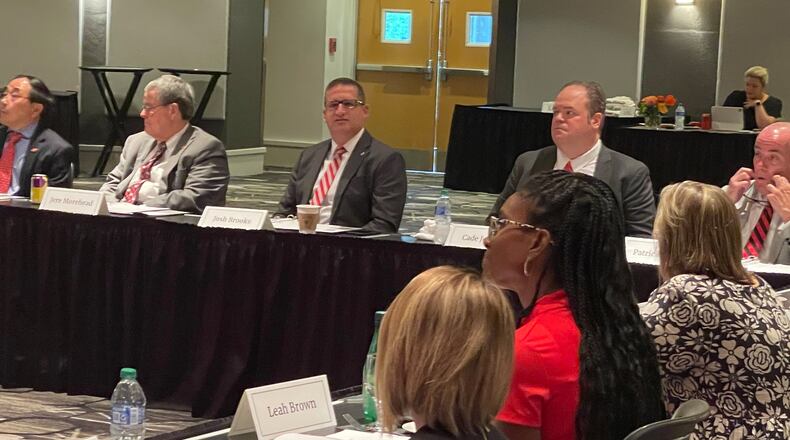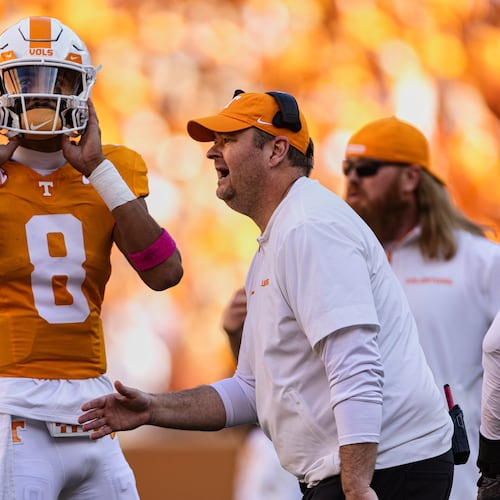ATHENS – The Georgia Bulldogs have some big plans. Like, really big.
That was the main message that came out of the fall meeting of the athletic association’s board of directors on Friday afternoon. Convening in the Mahler Room on the ground floor of the Georgia Center for Continuing Education, Athletic Director Josh Brooks and his staff informed the board of progress on at least seven new facility and improvement projects.
The one that seemed to get everybody most excited was Georgia’s plans to “build the biggest videoboard in all of athletics” at Stegeman Coliseum, according to Brooks. He said the Bulldogs have done research and determined that San Jose State currently has that distinction with a 2,300 square foot videoboard.
The one Georgia plans to build will cover the entire expanse of the wall on the eastern end of the Coliseum sometime during the 2024-25 academic year. Depending on what logistics will allow, it will be 6,000 to 7,000 square feet, according to Brooks. It’s all part of Georgia’s attempts to “improve the fan experience” inside the 60-year-old arena.
“Everything is in renderings and rough drafts right now, but the goal is to be around 7,000 square feet, if you look at the space we have on that wall,” Brooks told reporters after the 90-minute meeting had adjourned. “Now once you get into the design phase, you’ll see what you can actually build, but that’s the goal right now.”
The videoboard is just part of a multiphase plan to bring back to life Georgia’s old basketball arena and commencement center. The school already has poured millions of dollars into repairing the ceiling of the facility, which was forced to close in March due to flaking cement falling into seating areas surrounding the court. Brooks told the board that those repairs have been completed and the building will reopen in time for “Stegmania” to ring in the start of basketball practice on Oct. 6.
Meanwhile, the ceiling and entire interior has been painted black to match the black seats and the center-hung scoreboard will be permanently removed in the next stage of the multi-phase project. New team locker rooms and a dedicated, basketball-only weight room already have been added on the concourses.
Next, Brooks wants to explore premium seating/luxury box possibilities for the “horseshoe end” of the building. A request for proposal (RFP) was sent out last week for a design firms to compete on a master plan that will transform the building once called The Stegosaurus into one of the “best facilities in the country.”
“We’ve already invested a lot into it and done some really dramatic things,” Brooks said. “Now we want to keep that going. We’ve done a lot of research on arenas and coliseums like this one, whether it’s Madison Square Garden or State Farm Arena where’s there is great bones and you can keep building and improving. I am as excited as ever for the future of Stegeman Coliseum.”
Basketball is one of six facility projects currently online for the Bulldogs. Associate ADs Matt Brachowski and Tanner Stines detailed the progress of ongoing construction projects at Sanford Stadium (football), Foley Field (baseball), Jack Turner Stadium (softball), Lindsey Hopkins Indoor Courts (tennis) and the Vince Dooley Sports Complex (track and football).
New baseball coach Wes Johnson attended as a special guest and proved himself to be dynamic public speaker. The Bulldogs’ baseball facilities in the first phase of a $48 million improvement, much of which won’t be seen in the former of metal and concrete. Johnson’s baseball career has been built on his reputation as a cutting-edge pitching coach on both the college and the major-league levels. He told the board it is his goal is “to be No. 1 in the country in technology and analytics.”
The board also heard a report on the university from President Jere Morehead, an academic report from faculty-athletic representative and law professor David Shipley, a treasurer’s report from Ryan Nesbit, a compliance report from Will Lawler and reports from student-athletes Jabri Abdur-Rahim and Caterina Don and student government representative Parker Duncan.
The bottom line from all of them is Georgia’s bottom line is very good at the moment. At No. 7, UGA returned to the Top 10 of the Learfield Cup Standings for all-sport success. Nesbit reported UGA Athletics’ total assets for Fiscal Year were $592.4 million and total liabilities were $199.5 million. Academically, Georgia athletes’ combined grade-point average of 3.20 was the highest on record, as were the top men’s and women’s team GPAs, 3.72 for women’s cross country and 3.70 for men’s tennis.
“We have an athletic and academic powerhouse,” Brooks concluded, which brought “Go Dawgs!” exhortations from several members.
The meeting was adjourned with the Bulldogs feeling quite good about themselves.
About the Author
Keep Reading
The Latest
Featured



